Edible Biological Resource Use in an Agricultural Heritage System and Its Driving Forces: A Case of the Shuangjiang Mengku Ancient Tea and Culture System
Abstract
1. Introduction
2. Materials and Methods
2.1. Study Area
2.2. Methodology
3. Results
3.1. Demographic Features of Surveyed Households
3.2. Diversity of EBRs in SMATCS
3.2.1. Species diversity
- Edible plant diversity
- 2.
- Edible animal diversity
- 3.
- Edible fungus diversity
3.2.2. Edible Part Diversity
3.2.3. Harvest Season Diversity
3.2.4. Utilization Diversity
3.2.5. Food Preferences
3.3. Driving Forces of EBR Use
4. Discussion and Conclusions
4.1. Discussion
4.2. Conclusions
Author Contributions
Funding
Acknowledgments
Conflicts of Interest
Appendix A
| Usage | Ethnic group (L—Lahu, W—Wa, B—Bulang, D—Dai) | Species | Specific Usage |
| Medicine | L, W, B, and D | Houttuynia cordata Thunb. | Treating asthma, sore throat, and indigestion, eliminating inflammation, and detoxifying. |
| A. villosum Lour. | Treating indigestion, diarrhea, and preventing miscarriages. | ||
| Tricholoma matsutake (lto et lmai) Sing. | Treating dizziness, vomiting, and backache and such. | ||
| Ganoderma Lucidum (Leyss. ex Fr.) Karst. | Calming the nerves, eliminating phlegm, and enhancing immunity. | ||
| L, W and D | A. tsaoko Crevost et Lemarié | Treating indigestion, abdominal pain, and vomiting. | |
| Polyrhachis vicina Roger | Anti-inflammatory, antiaging, toning the kidney, strengthening the spleen. | ||
| L and W | Plantago depressa Willd. | Clearing heat, eliminating phlegm and inflammation, and detoxifying. | |
| W and B | C. japonica L. | Relieving a cough, eliminating inflammation, and hemostasis. | |
| L | O. sativa L. | Treating heatstroke and diarrhea. | |
| B | C. cassia Presl | Treating impotence, pain, and cold. | |
| D | J. duclouxii (H. Levl.) Rehd. | Relieving pain, swelling, and hemostasis | |
| P. rubra cv. Acutifolia | Treating diarrhea, bacillary dysentery, indigestion, and such. | ||
| C. bungei Steud. | Clearing heat, eliminating inflammation, and relieving pain. | ||
| Capsicum annuum L. | Increasing appetite, and clearing damp. | ||
| Squeeze oil | L, W, B, and D | Brassica rapa var. oleifera de Candolle | Extracting edible oil from mature individuals. |
| A. hypogaea L. | |||
| L, B, and D | S. indicum L. | ||
| L, W, and B | Glycine max (L.) Merr. | ||
| Animal feed | L, W, B, and D | Z. mays L. | Feeding poultry such as chickens and ducks. |
| L, B, and D | I. batatas (L.) Lam. | Feeding pigs. | |
| W, B, and D | G. max (L.) Merr. | Feeding pigs and chicken. | |
| Make ethnic equipment | B | Bos taurus domesticus | Made from the hide of cattle and the bark of J. sambac (L.) Aid. to make the Fengtonggu (bee barrel drum). |
| Usage | Minority (L—Lahu, W—Wa, B—Bulang, D—Dai) | Species | Specific Usage |
| Obsequies | L | Gallus gallus domesticus and O. sativa L. | Dedicating rice and chicken to the dead before interment. |
| Gallus gallus domesticus and Sus scrofa | Relatives and villagers who attend the funeral carry away these in consolation. | ||
| W | C. sinensis var. assamica (J. W. Mast.) Kitamura | Putting tea, salt, or sugar in the mouth of the dead person. | |
| C. sinensis var. assamica (J. W. Mast.) Kitamura, O. sativa L., Nicotiana tabacum L. | Relatives and villagers who attend the funeral carry away these in consolation. | ||
| Brew wine | W and D | Z. mays L. | Fermentation using cooked corn, sugar, cold water, and enzymes. |
| W | O. sativa L. | Fermentation using cooked rice and enzymes. | |
| D | Saccharum officinarum L. | Fermentation using squeezed fruits and enzymes. | |
| Solanum tuberosum L. | Fermentation using cooked potato (S. tuberosum L.), mud, and enzymes. | ||
| Brew vinegar | D | O. sativa L. and Tamarindus indica L. | Fermentation using the fruits of tamarind (T. indica L.), glutinous rice, brown sugar, wine and cold water. |
| Sacrifice | L | Gallus gallus domesticus | Divination through observing the comb, feet and skeleton of a chicken. |
| O. sativa L., Z. mioga (Thunb.) Rosc. and Gallus gallus domesticus | (1) Dedicating glutinous rice to the Fire God and their ancestors (New Year’s Day); (2) burning the stem and leaves of Z. mioga (Thunb.) Rosc. to exorcise the spirit and dedicating a chicken to pray for safety (second day of the first month of the lunar calendar). | ||
| Sus scrofa and C. sinensis var. assamica (J. W. Mast.) Kitamura | Worshiping ancestors (8th day of the second month of the lunar calendar). | ||
| B | Gallus gallus domesticus, O. sativa L. | Plugging feathers of chicken beside the root of the Dragon Tree to worship the tree, dropping chicken blood around the altar, and offering chicken and glutinous rice as sacrifices on the altar (Songkran Festival). | |
| W | M. basjoo, Sus scrofa, S. officinarum L., C. sinensis var. assamica (J. W. Mast.) Kitamura, O. sativa L., Z. mays L. | Dedicating items to their ancestors to pray for safety and happiness. | |
| D | Bos taurus domesticus, Sus scrofa, O. sativa L., S. officinarum L., Z. mays L. and S. tuberosum L. | Dedicating items in the Buddhist temple to pray for safety. |
References
- Lou, Z.P.; Lai, R.; Miao, H.X. Conservation of Biodiversity and Sustainable Utilization of Biological Resources. Bull. Chin. Acad. Sci. 2012, 27, 359–365. [Google Scholar]
- Sharma, L.; Samant, S.S.; Kumar, A.; Lal, M.; Devi, K.; Tewari, L.M. Diversity, Distribution Pattern, Endemism and Indigenous Uses of Wild Edible Plants in Cold Desert Biosphere Reserve of Indian Trans Himalaya. Indian J. Tradit. Knowl. 2018, 17, 122–131. [Google Scholar]
- Rangel-Landa, S.; Casas, A.; Garcia-Frapolli, E.; Lira, R. Sociocultural and Ecological Factors Influencing Management of Edible and Non-Edible Plants: The Case of Ixcatlán, Mexico. J. Ethnobiol. Ethnomedicine 2017, 13, 59. [Google Scholar] [CrossRef] [PubMed]
- Wu, J.; Hou, Y.; Wen, Y. Tourist Behavior and Conservation Awareness on Eating Wild Edible Plants in Mountainous Protected Areas: A Case Study in Northwest China. J. Sustain. For. 2018, 1–15. [Google Scholar] [CrossRef]
- Xu, F.R.; Tang, C.F.; Yu, T.Q.; Dai, L.Y.; Zhang, H.S. Diversity of Paddy Rice Varieties from Yuanyang Hani’s Terraced Fields in Yunnan, China. Acta Ecol. Sin. 2010, 30, 3346–3357. [Google Scholar]
- Yu, M.; Yang, Y.X.; Shu, X.Y.; Huang, J.; Hou, D.-B. Aconitum carmichaelii Debeaux, Cultivated as a Medicinal Plant in Western China. Genet. Resour. Crop. Evol. 2016, 63, 919–924. [Google Scholar] [CrossRef]
- Weldegerima, B. Review on the Importance of Documenting Ethnopharmacological Information on Medicinal Plants. Afr. J. Pharm. Pharmacol. 2009, 3, 400–403. [Google Scholar]
- Singh, A.; Gupta, R.; Saikia, S.K.; Pant, A.; Pandey, R. Diseases of Medicinal and Aromatic Plants, Their Biological Impact and Management. Plant. Genet. Resour. 2016, 14, 370–383. [Google Scholar] [CrossRef]
- Saslis-Lagoudakis, C.H.; Hawkins, J.A.; Greenhill, S.J.; Pendry, C.A.; Watson, M.F.; Tuladhar-Douglas, W.; Baral, S.R.; Savolainen, V. The Evolution of Traditional Knowledge: Environment Shapes Medicinal Plant Use in Nepal. Proc. R. Soc. B-Biol. Sci. 2014, 281, 1–7. [Google Scholar] [CrossRef]
- Shiyomi, M. From Agriculture Based on Fossil Fuel Resources to Agriculture Based on Biological Interactions and Matter Cycling in Agroecosystems. Grassl. Sci. 2005, 51, 3–13. [Google Scholar] [CrossRef]
- Chojnacka, K.; Moustakas, K.; Witek-Krowiak, A. Bio-Based Fertilizers: A Practical Approach towards Circular Economy. Bioresour. Technol. 2020, 295. [Google Scholar] [CrossRef] [PubMed]
- Medhi, R.; Chakraborti, M. Rampal Orchid Biodiversity in India: Conservation and Utilization. Indian J. Genet. Plant. Breed. 2012, 72, 148–156. [Google Scholar] [CrossRef]
- He, X.Y.; Yu, J.H. Technology and Demonstration of Ecological Protection and Exploitation and Utilization of Biological Resources in Northeast Forest Region. Acta Ecol. Sin. 2016, 36, 7028–7033. [Google Scholar]
- Jones, R.W.; Hill, J.M.; Coetzee, J.A.; Hill, M.P. The Contributions of Biological Control to Reduced Plant Size and Biomass of Water Hyacinth Populations. Hydrobiologia 2017, 807, 377–388. [Google Scholar] [CrossRef]
- Douglas, S.; Agus, S. Diversity of Locally Useful Tropical Forest Wild-Plants as a Function of Species Richness and Informant Culture. Biodivers. Conserv. 2012, 21, 687–699, 8. [Google Scholar]
- Chasca, T. Natural Resource Use and Livelihoods in Botswana’s Wildlife Management Areas. Appl. Geogr. 2001, 21, 45–68. [Google Scholar]
- Elizabeth, J.Z.R. Resource-Dependent Livelihoods and the Natural Resource Base. Annu. Rev. Resour. Econ. 2016, 8, 281–301. [Google Scholar]
- Min, Q.W.; Zhang, B.T. Research Progress in the Conservation and Development of China-Nationally Important Agricultural Heritage Systems (China-NIAHS). Sustainability 2020, 12, 126. [Google Scholar] [CrossRef]
- Zhang, D.; Min, Q.W.; He, L.; Yuna, Z. Agrobiodiversity Features, Conservation and Utilization of China’s Globally Important Agricultural Heritage Systems. Chin. J. Eco-Agric. 2016, 24, 451–459. [Google Scholar] [CrossRef]
- Yuan, Z.; Lun, F.; He, L.; Cao, Z.; Min, Q.W.; Bai, Y.Y.; Liu, M.C.; Cheng, S.K.; Li, W.H.; Fuller, A.M. Exploring the State of Retention of Traditional Ecological Knowledge (TEK) in a Hani Rice Terrace Village, Southwest China. Sustainability 2014, 6, 4497–4513. [Google Scholar] [CrossRef]
- Hesham, A.; Agrama Yan, W.G. Genetic Diversity and Relatedness of Rice Cultivars Resistant to Straighthead Disorder. Plant Breed. 2010, 129, 304–312. [Google Scholar]
- Lin, J.J.; Li, J.B.; Liu, L.; Li, X.; Li, H.F.; He, X.H.; Zhu, S.S.; Li, C.Y.; Zhu, Y.Y. Genetic Diversity of Magnaporthegrisea of Hani Terrace from Yuanyang County in Yunnan. Acta Phytopathol. Sin. 2009, 39, 43–51. [Google Scholar] [CrossRef]
- Tian, M.; Min, Q.W.; Jiao, W.J.; Yuan, Z.; Fuller, A.M.; Yang, L.; Zhang, Y.X.; Zhou, J.; Cheng, B. Agricultural Heritage Systems Tourism: Definition, Characteristics and Development Framework. J. Mt. Sci. 2016, 13, 440–454. [Google Scholar] [CrossRef]
- Zhang, Y.X.; Min, Q.W.; Li, H.Y.; He, L.L.; Zhang, C.Q.; Yang, L. A Conservation Approach of Globally Important Agricultural Heritage Systems (GIAHS): Improving Traditional Agricultural Patterns and Promoting Scale-Production. Sustainability 2017, 9, 295. [Google Scholar] [CrossRef]
- Min, Q.W.; Zhang, D.; He, L.; Sun, Y.H. Agri-Cultural Heritage Research and Conservation Practices in China: Progresses and Perspectives. Resour. Sci. 2011, 33, 1018–1024. [Google Scholar]
- Dong, S.L. Plant. Resources Science; Northeast Forestry University: Harbin, China, 1994; pp. 29–36. ISBN 978-0-1970-1873-8. [Google Scholar]
- Dansi, A.; Adjatin, A.; Adoukonou-Sagbadja, H.; Faladé, V.; Adomou, A.C.; Yedomonhan, H.; Akpagana, K.; Foucault, B.D. Traditional Leafy Vegetables in Benin: Folk Nomenclature, Species Under Threat and Domestication. Acta Bot. Gall. Bull. Société Bot. Fr. 2013, 156, 183–199. [Google Scholar] [CrossRef][Green Version]
- Mtileni, B.J.; Muchadeyi, F.C.; Maiwashe, A.; Chimonyo, M.; Dzama, K. Conservation and Utilization of Indigenous Chicken Genetic Resources in Southern Africa. Worlds Poult. Sci. J. 2012, 68, 727–748. [Google Scholar] [CrossRef]
- Pandey, A.; Pandey, R.; Negi, K.S.; Radhamani, J. Realizing Value of Genetic Resources of Allium in India. Genet. Resour. Crop. Evol. 2008, 55, 985–994. [Google Scholar] [CrossRef]
- Pandey, A.; Nayar, E.R.; Venkateswaran, K.; Bhandari, D.C. Genetic Resources of Prunus (Rosaceae) in India. Genet. Resour. Crop. Evol. 2008, 55, 91–104. [Google Scholar] [CrossRef]
- Gharaghani, A.; Solhjoo, S.; Oraguzie, N. A Review of Genetic Resources of Pome Fruits in Iran. Genet. Resour. Crop. Evol. 2016, 63, 151–172. [Google Scholar] [CrossRef]
- Van Itterbeeck, J.; Andrianavalona, I.N.R.; Rajemison, F.I.; Rakotondrasoa, J.F.; Ralantoarinaivo, V.R.; Hugel, S.; Fisher, B.L. Diversity and Use of Edible Grasshoppers, Locusts, Crickets, and Katydids (Orthoptera) in Madagascar. Foods 2019, 8, 666. [Google Scholar] [CrossRef] [PubMed]
- Blanco-Salas, J.; Gutiérrez-García, L.; Labrador-Moreno, J.; Ruiz-Téllez, T. Wild Plants Potentially Used in Human Food in the Protected Area “Sierra Grande de Hornachos” of Extremadura (Spain). Sustainability 2019, 11, 456. [Google Scholar] [CrossRef]
- Elia, A.; Santamaria, P. Biodiversity in Vegetable Crops, a Heritage to Save: The Case of Puglia Region. Ital. J. Agron. 2013, 8, 21–34. [Google Scholar] [CrossRef]
- Sujarwo, W.; Arinasa, I.B.K.; Caneva, G.; Guarrera, P.M. Traditional Knowledge of Wild and Semi-Wild Edible Plants Used in Bali (Indonesia) to Maintain Biological and Cultural Diversity. Plant. Biosyst. 2016, 150, 971–976. [Google Scholar] [CrossRef]
- Liu, B.; Zhang, X.B.; Bussmann, R.W.; Hart, R.H.; Li, P.; Bai, Y.J.; Long, C.L. Garcinia in Southern China: Ethnobotany, Management, and Niche Modeling. Econ. Bot. 2017, 70, 1–15. [Google Scholar] [CrossRef]
- Shao, H. Cataloging of Traditional Knowledge of Biodiversity of Wa Nationality and the Case Study of the Change of Traditional Vegetable Resources. Master’s Thesis, Minzu University, Beijing, China, 2017. [Google Scholar]
- Piao, J.L. Cataloging of Traditional Knowledge of Biodiversity of Lahu Nationality and the Case Study of Medicine Knowledge. Master’s Thesis, Minzu University, Beijing, China, 2016. [Google Scholar]
- Guan, Q.Y. Cataloging of Traditional Knowledge of Biodiversity of Naxi Nationality and the Case Study of Traditional Diet Knowledge. Master’s Thesis, Minzu University, Beijing, China, 2016. [Google Scholar]
- Ma, N.; Min, Q.W.; Yuan, Z.; Li, W.H.; Yang, Q.C. The Wild Edible Plants of Four Main Ethnic Groups in the Lahu-Va-Blang-Dai Autonomous County of Shuangjiang in Yunnan Province. Resour. Sci. 2017, 39, 1406–1416. [Google Scholar] [CrossRef][Green Version]
- Marcelo, A.R.; Reinaldo, F.P.L.; Ulysses, P.A. What Drives the Knowledge and Local Uses of Timber Resources in Human-Altered Landscapes in the Semiarid Region of Northeast Brazil? Int. J. Sustain. Dev. World Ecol. 2015, 22, 545–559. [Google Scholar]
- Sun, Y.H.; Mary, J.D.C.; Min, Q.W.; Liu, M.C.; Zhang, L.Y. Conserving Agricultural Heritage Systems through Tourism: Exploration of Two Mountainous Communities in China. J. Mt. Sci. 2013, 10, 962–975. [Google Scholar] [CrossRef]
- Zhou, J.H.; Dao, L.F. Changes of Political Relations Between Village Communities of the Dai Nationality—A Case Study of Menglian County and Shuangjiang County in Yunnan Province. Soc. Sci. Yunnan 2014, 103–108. [Google Scholar]
- Gao, L. The Tradition of “Ancient Root” of Lahu Ethnic Group in the Village Context—Taking Mangpin Village in Shuangjiang County of Yunnan Province as an Example. Master’s Thesis, Yunnan University, Yunnan, China, 2017. (In Chinese). [Google Scholar]
- Huang, C.W. Blang Culture in Social Change—Anthropological Investigation in a Blang Village of Shuangjiang County. J. Chuxiong Norm. Univ. 2010, 25, 52–59. (In Chinese) [Google Scholar]
- Xu, G.X.; Zeng, W.T.; Sun, Z.B.; Huang, L.; Chen, G.Y.; Tian, S.M.; Zhou, K. Petrology and Mineralogy of (Retrograded) Eclogites from Mengku Area, Shuangjiang County, Western Yunnan Province. Geol. Bull. China 2016, 35, 1035–1045. (In Chinese) [Google Scholar] [CrossRef]
- Liu, G.C.; Sun, Z.B.; Zeng, W.T.; Feng, Q.L.; Huang, L.; Zhang, H. The Age of Wanhe Ophiolitic MÉLange from Mengku Area, Shuangjiang County, Western Yunnnan Province, and its Geological Significance. Acta Petrol. Miner. 2017, 36, 163–174. (In Chinese) [Google Scholar] [CrossRef]
- Yang, J.W. Study on The Feasibility of The Practice of Shuangjiang County Brown Folk Song into Junior High School Music Class—In the First High School in Shuangjiang County as an Example. Master’s Thesis, Yunnan Normal University, Yunnan, China, 2018. (In Chinese). [Google Scholar]
- Ji, H.; Lu, Y.; Wu, J.; Gao, W.K.; Zeng, P.F.; Yang, X.; Zi, W.H. Climate Characteristic Analysis and Risk Evaluation on Tobacco-Planting Areas in Shuangjiang County in Lincang City. Tob. Sci. Technol. 2016, 49, 30–36. (In Chinese) [Google Scholar] [CrossRef]
- Yang, C.R.; Zhang, Y.J.; Yang, C.R. The Occurrence of 8-Oxocaffeine and Pyrimidine Alkaloids in Pu-Er Ripe Tea. Acta Bot. Yunnanica 2007, 713–716. (In Chinese) [Google Scholar]
- Zhao, Y.; Cao, X.L.; Wen, P.C.; Tan, H.C. Application of Bamboo Tissue Culture Seedling on Bamboo Fast Foster. For. Inventory Plan. 2012, 37, 131–133. (In Chinese) [Google Scholar]
- Sun, J.X.; Xiong, Y.; Li, Y.H.; Yang, Q.S.; Chen, Y.J.; Jiang, M.Y.; Li, Y.K.; Li, H.R.; Bi, Z.Z.; Huang, X.Z.; et al. Medicinal Dietary Plants of the Yi in Mile, Yunnan, China. J. Ethnobiol. Ethnomed. 2020, 16, 48. [Google Scholar] [CrossRef]
- Ambu, G.; Chaudhary, R.P.; Mariotti, M.; Cornara, L. Traditional Uses of Medicinal Plants by Ethnic People in the Kavrepalanchok District, Central Nepal. Plants 2020, 9, 759. [Google Scholar] [CrossRef]
- Conlon, C.; Timonen, V.; Elliott-O’Dare, C.; O’Keeffe, S.; Foley, G. Confused about theoretical sampling? engaging theoretical sampling in diverse grounded theory studies. Qualitative Health Research, 30(6), 104973231989913. Confused About Theoretical Sampling? Engaging Theoretical Sampling in Diverse Grounded Theory Studies. Qual. Health Res. 2020, 30, 947–959. [Google Scholar] [CrossRef]
- Cathy, U.; Hans, L.; Michael, D.M. Putting The ‘Theory’ Back into Grounded Theory: Guidelines for Grounded Theory Studies in Information Systems. Inf. Syst. J. 2010, 20, 357–381. [Google Scholar] [CrossRef]
- Zheng, D.S.; Li, X.X.; Chen, S.C.; Gao, A.N.; Li, L.H.; Liu, X. Resources of Wild Vegetable and Wild Fruit in Yunnan Province and Its Peripheral Area. J. Plant. Genet. Resour. 2013, 985–990. (In Chinese) [Google Scholar] [CrossRef]
- Shen, T.; Jia, L.; Yang, Y.L.; Zhang, Y. Mineral Elemental Fingerprint of Dioscorea L. Species from Yunnan, China. Chin. J. Trop. Crop. 2014, 35, 2332–2339. (In Chinese) [Google Scholar] [CrossRef]
- Li, J.M. Comparison of Genetic Diversity of On-Farm Conservation Rice Landraces Collected in Different Periods in Yunnan, China. Master’s Thesis, Minzu University, Beijing, China, 2014. (In Chinese). [Google Scholar]
- Li, S.Y.; Bi, T.J. Preliminary Exploration on Ethnic Insectivorous Culture in Puer Yunan. J. Anhui Agric. Sci. 2012, 40, 1028–1030. (In Chinese) [Google Scholar] [CrossRef]
- Zhang, D.Z.; Aziguli Chen, H.Y. Research on Cognitive Induction Based Knowledge Acquisition. In Proceedings of the International Forum on Computer Science-technology and Applications, Chongqing, China, 25–27 December 2009; pp. 227–234. [Google Scholar]
- Liu, M.C.; Yang, L.; Bai, Y.Y.; Min, Q.W. The Impacts of Farmers’ Livelihood Endowments on Their Participation in Eco-Compensation Policies: Globally Important Agricultural Heritage Systems Case Studies from China. Land Use Policy 2018, 77, 231–239. [Google Scholar] [CrossRef]
- National Bureau of Statistics of China, Per Capita Annual Income of Rural Households. Available online: http://data.stats.gov.cn/easyquery.htm?cn=C01&zb=A0A05&sj=2015 (accessed on 20 February 2020).
- Liu, W.W.; Li, W.H.; Liu, M.C.; Fuller, A.M. Traditional Agroforestry Systems: One Type of Globally Important Agricultural Heritage Systems. J. Resour. Ecol. 2014, 5, 306–313. [Google Scholar] [CrossRef]
- Jiao, W.J.; Min, Q.W.; Cheng, S.K.; Zhang, D.; Sun, Y.H. The Emergy-Based Ecological Footprint (EEF) of Traditional Agricultural Areas in China: The Case Study of Congjiang County, Guizhou Province. J. Resour. Ecol. 2011, 2, 289–299. [Google Scholar] [CrossRef]
- Yang, L.; Liu, M.C.; Lun, F.; Min, Q.W.; Li, W.H. The Impacts of Farmers’ Livelihood Capitals on Planting Decisions: A Case Study of Zhagana Agriculture-Forestry-Animal Husbandry Composite System. Land Use Policy 2019, 86, 208–217. [Google Scholar] [CrossRef]
- Zhang, L.L.; Chai, Z.Z.; Zhang, Y.; Geng, Y.F.; Wang, Y.H. Ethnobotanical Study of Traditional Edible Plants Used by The Naxi People During Droughts. J. Ethnobiol. Ethnomed. 2016, 12, 1–16. [Google Scholar] [CrossRef]
- Fan, D.M. Cataloging of Traditional Knowledge of Biodiversity of Dai Nationality and the Case Study of Medicine Knowledge. Master’s Thesis, Minzu University, Beijing, China, 2017. (In Chinese). [Google Scholar]
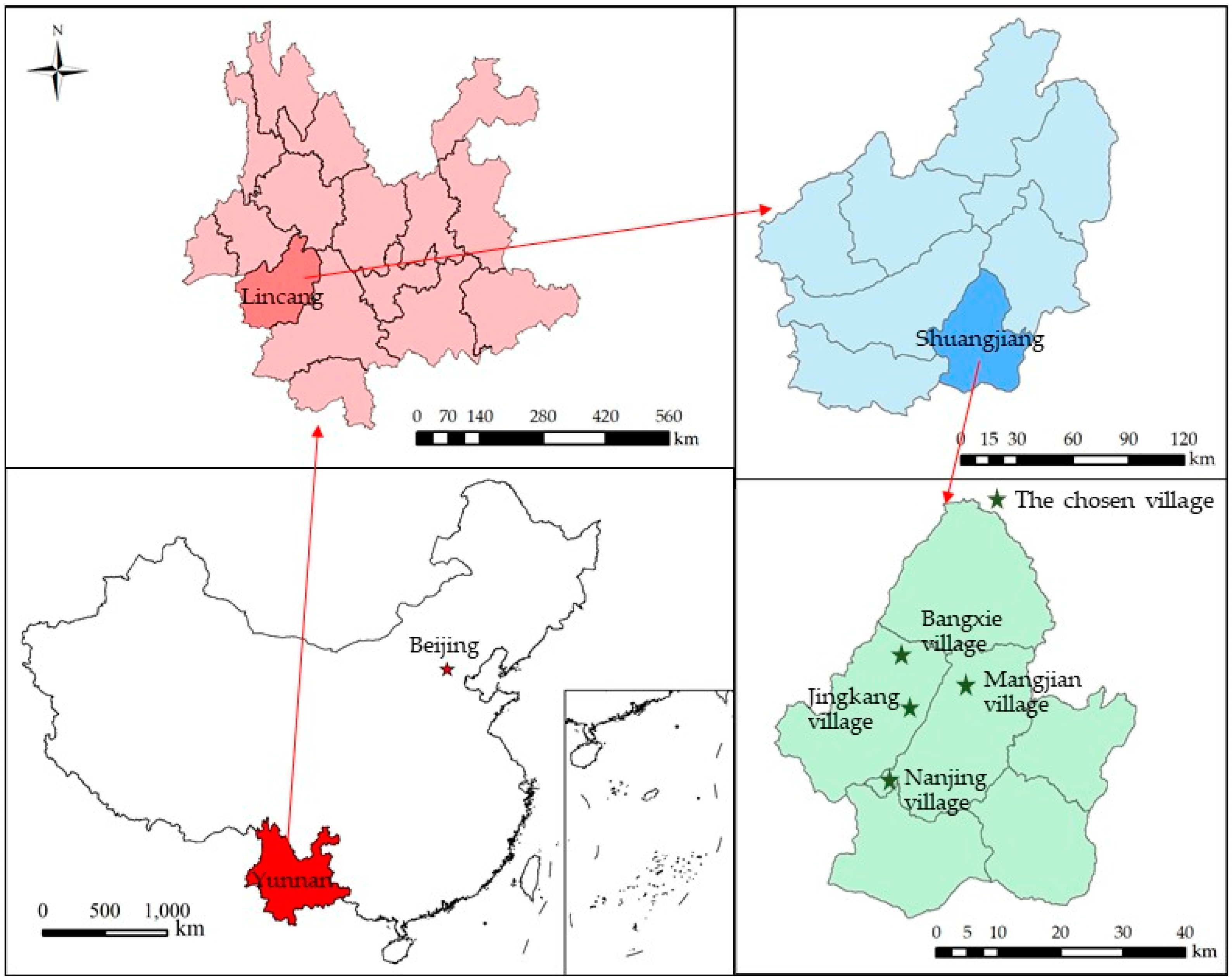

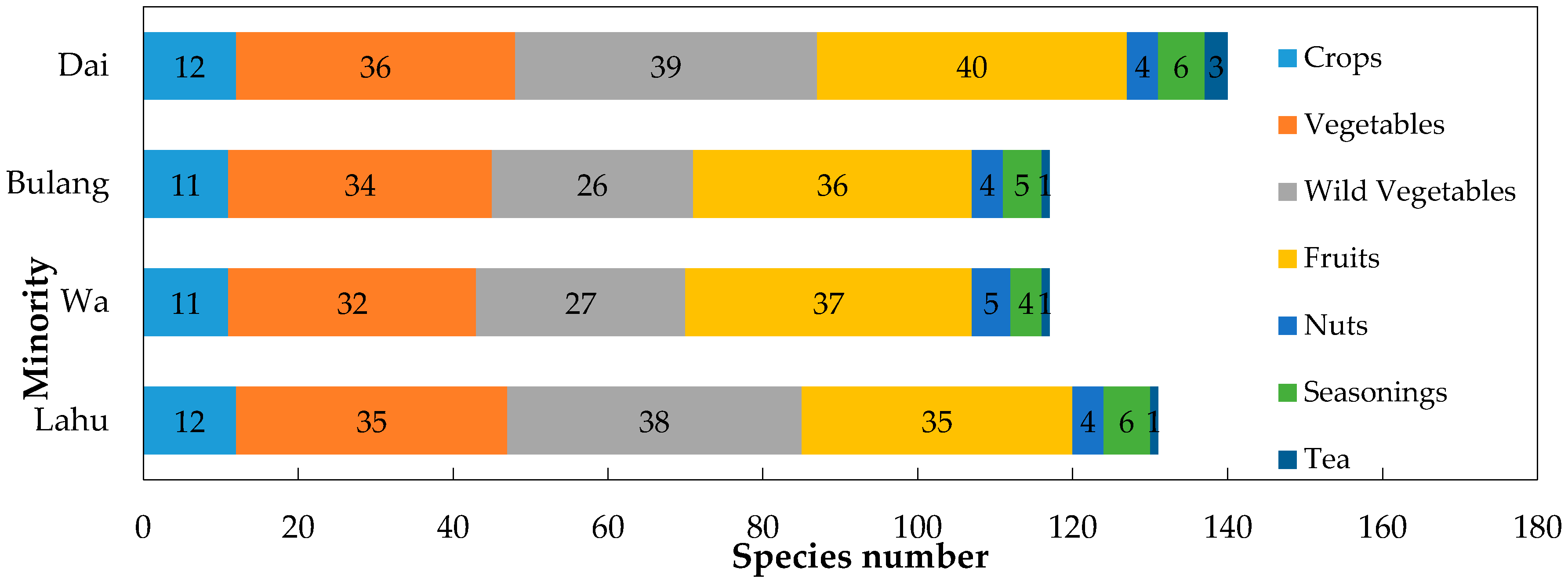
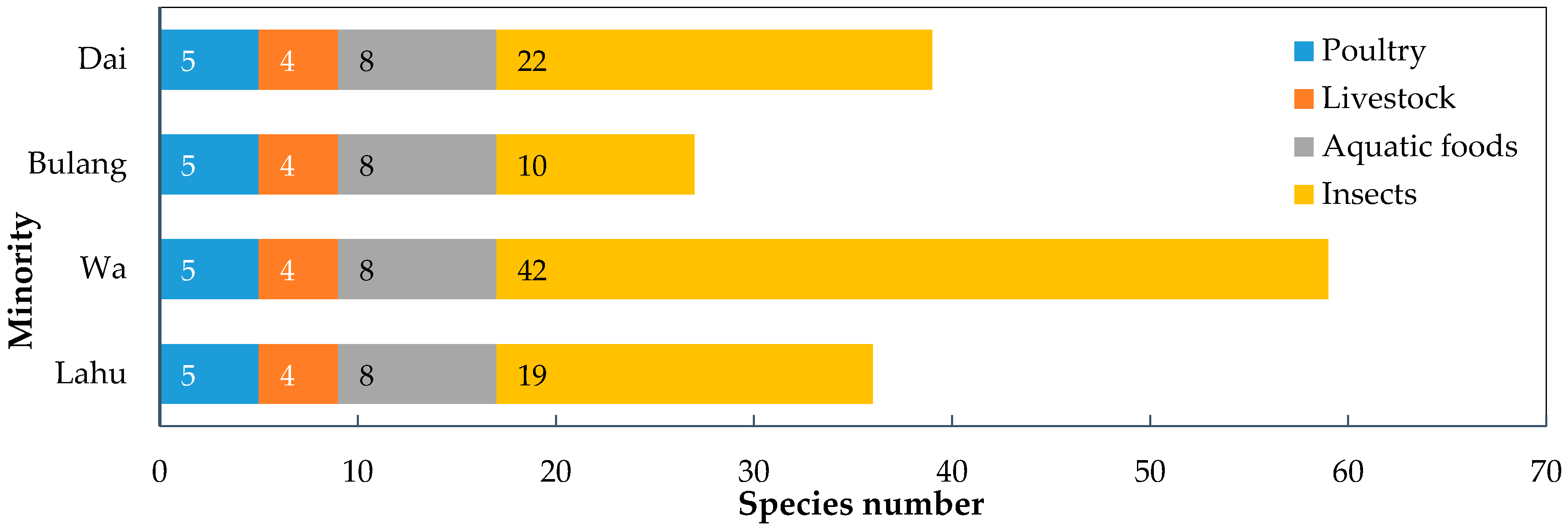
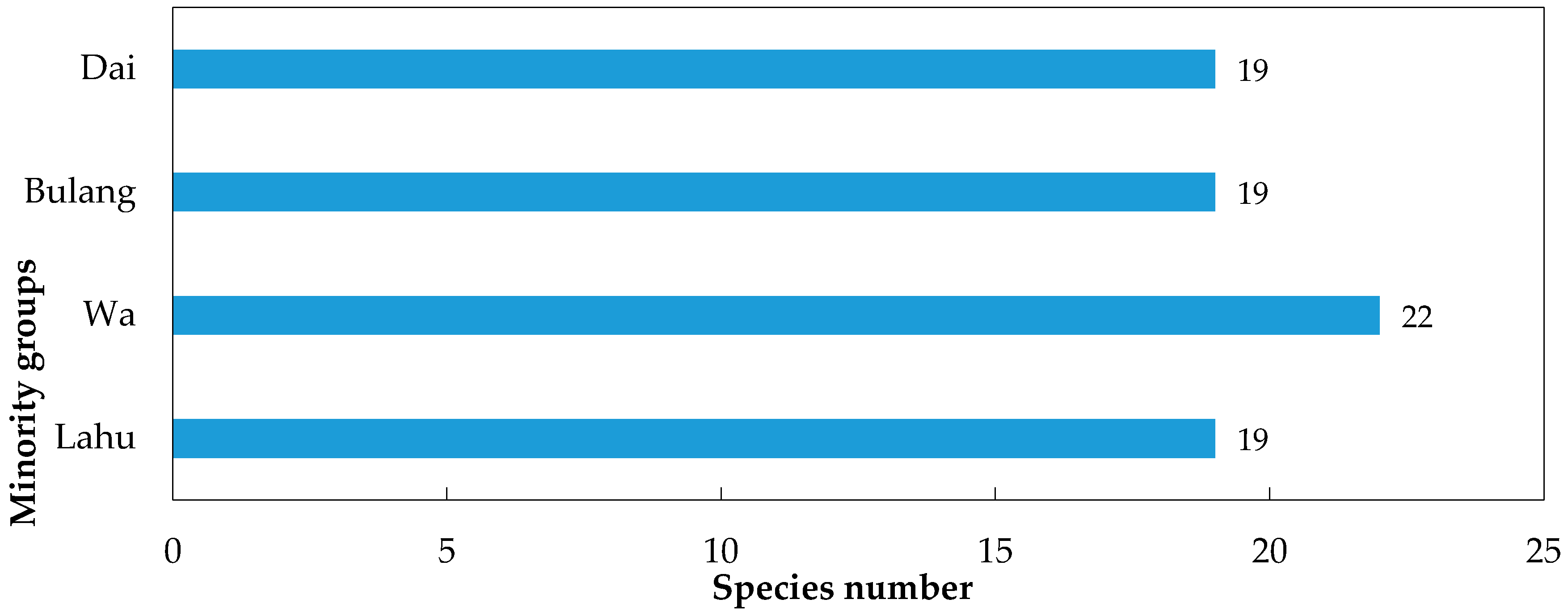
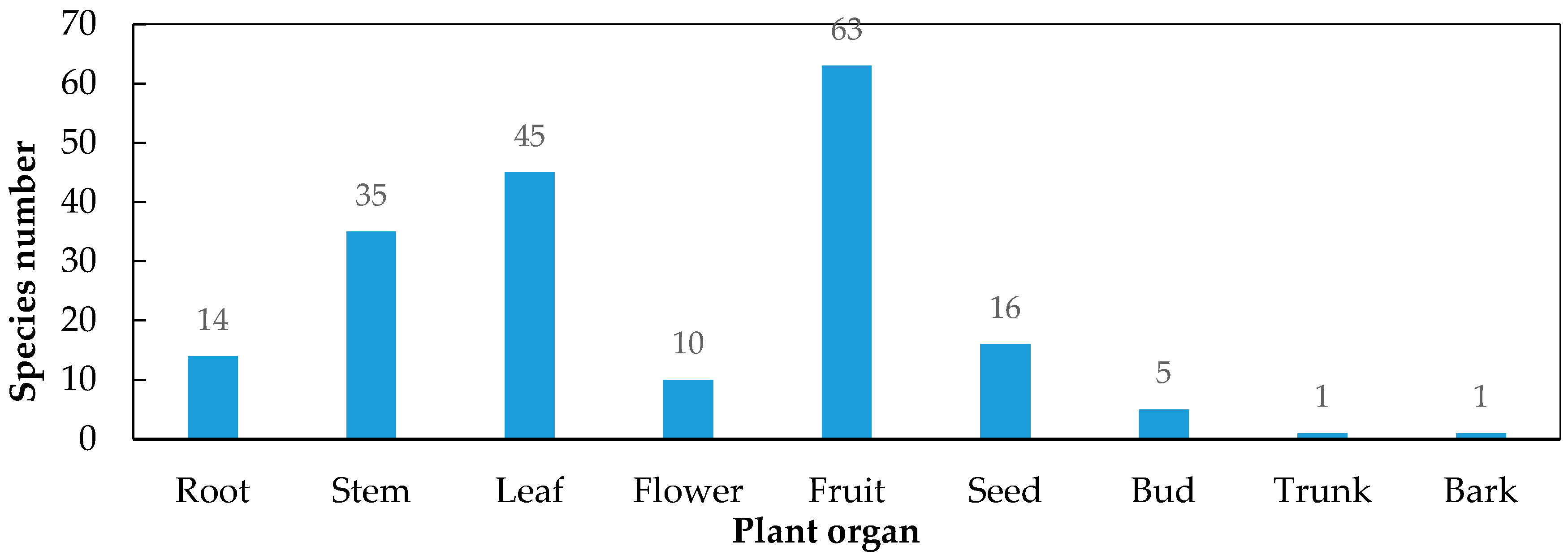
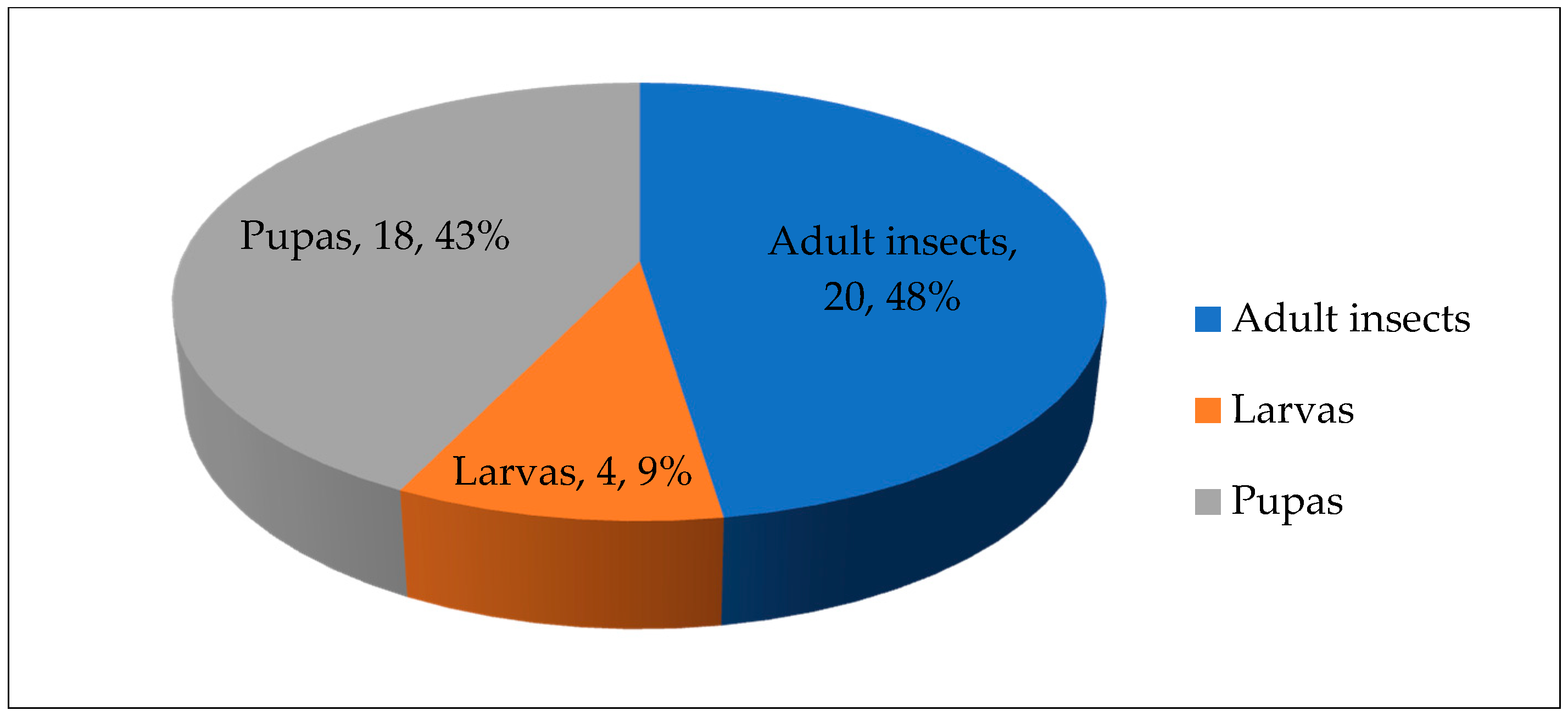
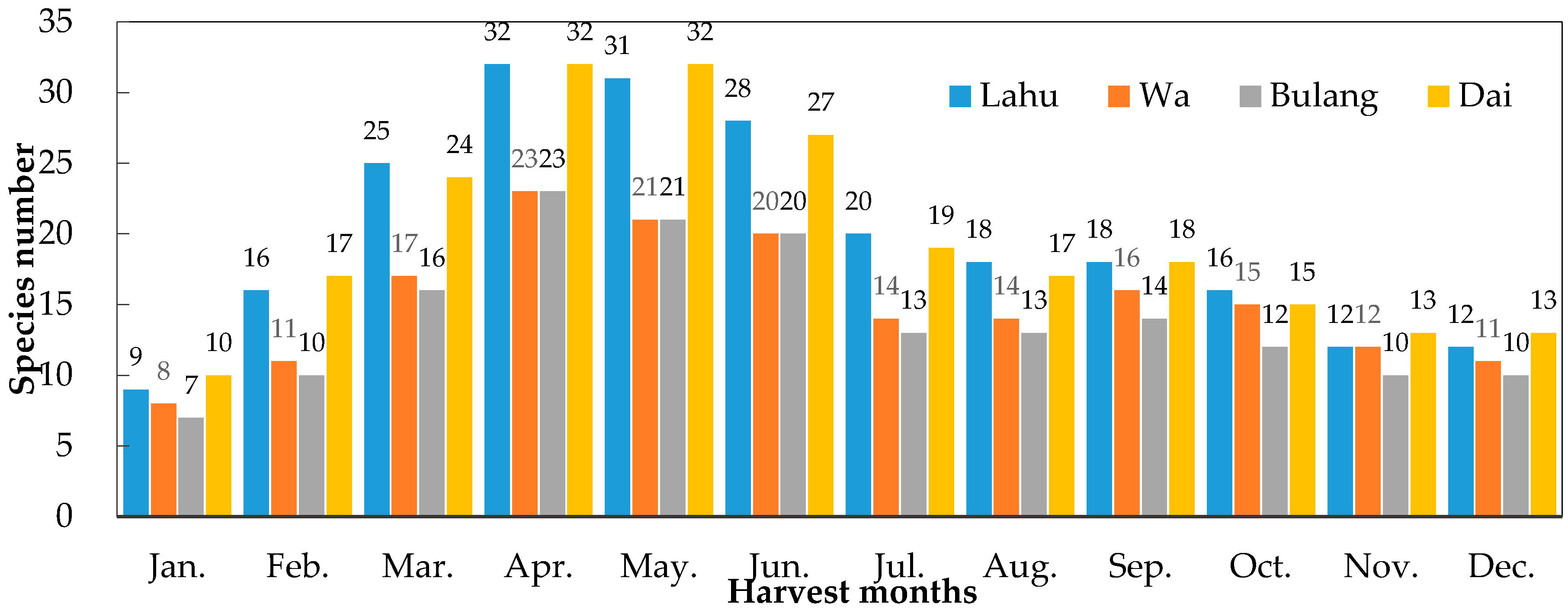
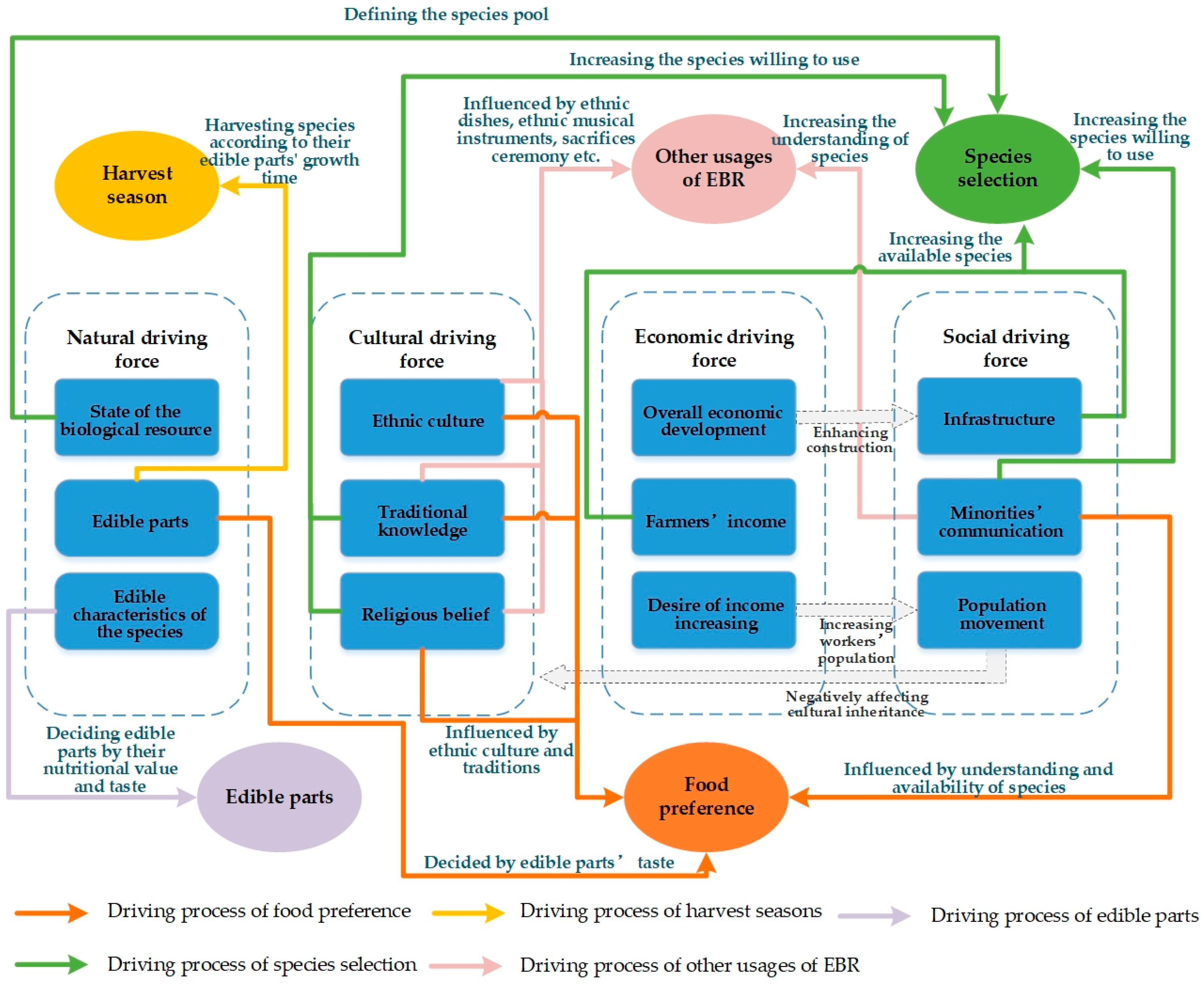
| Village | Mangjian | Nanjing | Bangxie | Jingkang |
|---|---|---|---|---|
| Minority group | Lahu | Wa | Bulang | Dai |
| Proportion of the minority in the village | 99.2% | 100% | 98.66% | 97.1% |
| Religions | Primitive religion | Primitive religion and Buddhism | Buddhism | Buddhism |
| Eating preference | Spicy food, boiled food, and grilled food | Boiled food and white spirit | Spicy and sour food, and tea | Spicy and sour food, and white spirit |
| Altitude (meters) | 1300 | 1400 | 1500 | 1050 |
| Climate | South subtropical warm and humid monsoon climate | |||
| Variable | Average Value/Percentage |
|---|---|
| Total number of family members (person) | 5.3 |
| Male householder | 67.5% |
| Female householder | 32.5% |
| Average age of the householder (year) | 52.2 |
| Householder age (≤40) | 20% |
| Householder age (40~50) | 20% |
| Householder age (50~60) | 42.5% |
| Householder age (60~70) | 15% |
| Householder age (70~80) | 2.5% |
| Household average annual per capita income (≤5000 Yuan) | 32.5% |
| Household average annual per capita income (5000~10,000 Yuan) | 42.5% |
| Household average annual per capita income (10000~15,000 Yuan) | 17.5% |
| Household average annual per capita income (>15,000 Yuan) | 7.5% |
| Education level of householder (primary school) | 75% |
| Education level of householder (junior high school) | 22.5% |
| Education level of householder (high school) | 2.5% |
| Average number of migrant workers per household | 0.7 |
| Types | Number | ||||
|---|---|---|---|---|---|
| Lahu | Wa | Bulang | Dai | ||
| Total species | Plants | 131 | 117 | 116 | 140 |
| Animals | 36 | 59 | 27 | 39 | |
| Fungi | 19 | 22 | 19 | 19 | |
| Traditional varieties | Plants | 74 | 63 | 59 | 78 |
| Animals | 18 | 18 | 17 | 18 | |
| Fungi | 18 | 18 | 16 | 19 | |
| Endemic edible varieties | Plants | 7 | 4 | 1 | 16 |
| Animals | 0 | 14 | 0 | 0 | |
| Fungi | 1 | 2 | 0 | 0 | |
| Minority Group | Other Uses of EBR | Number of EBR Species | Percentage of All EBR Species |
|---|---|---|---|
| Lahu | Used as medicine, extract oil, used as feed, in obsequies and sacrifices. | 18 | 9.68% |
| Wa | Used as medicine, extract oil, used as feed, in obsequies, winemaking, and in sacrifices | 20 | 10.10% |
| Bulang | Used as medicine, extract oil, used as feed, in making ethnic artifacts, and in sacrifices | 15 | 9.88% |
| Dai | Used as medicine, extract oil, used as feed, in winemaking, brewing vinegar, and in sacrifices | 22 | 11.11% |
| Consumption Type | Preferred Food Species | |||
|---|---|---|---|---|
| Lahu | Wa | Bulang | Dai | |
| Crop | O. sativa L. | O. sativa L. | O. sativa L. | O. sativa L. |
| Vegetable | B. rapa var. glabra Regel | B. rapa var. chinensis (L.) Kitamura | B. rapa var. chinensis (L.) Kitamura | B. rapa var. glabra Regel |
| Wild vegetable | H. cordata Thunb. | Pteridium aquilinum var. latiusculum | H. cordata Thunb. | H. cordata Thunb. |
| Fruit | C. reticulata Blanco | C. reticulata Blanco | Malus pumila Mill. | M. pumila Mill. |
| Nut | A. hypogaea L. | M. ternifolia F. Muell. | J. regia L. | J. regia L. |
| Seasoning | A. tsao-ko Crevost et Lemarié | A. tsao-ko Crevost et Lemarié | A. tsao-ko Crevost et Lemarié | P. viscosum Buch.-Ham. ex D. Don |
| Tea | C. sinensis var. assamica (J. W. Mast.) Kitamura | C. sinensis var. assamica (J. W. Mast.) Kitamura | C. sinensis var. assamica (J. W. Mast.) Kitamura | C. sinensis var. assamica (J. W. Mast.) Kitamura |
| Poultry | Gallus gallus domesticus | Gallus gallus domesticus | Gallus gallus domesticus | Gallus gallus domesticus |
| Livestock | Sus scrofa | Sus scrofa | Sus scrofa | Bos taurus domesticus |
| Aquatic food | Tor sinensis | Tor sinensis | Tor sinensis | Tor sinensis |
| Insect | Pine moth | Stinkbug | Bee | Pine moth |
| Fungus | Lactarius volemus Fr. | L. volemus Fr. | Termitornyces albuminosus (Berk) Heim | T. albuminosus (Berk) Heim |
© 2020 by the authors. Licensee MDPI, Basel, Switzerland. This article is an open access article distributed under the terms and conditions of the Creative Commons Attribution (CC BY) license (http://creativecommons.org/licenses/by/4.0/).
Share and Cite
Ma, N.; He, S.; Min, Q. Edible Biological Resource Use in an Agricultural Heritage System and Its Driving Forces: A Case of the Shuangjiang Mengku Ancient Tea and Culture System. Sustainability 2020, 12, 7791. https://doi.org/10.3390/su12187791
Ma N, He S, Min Q. Edible Biological Resource Use in an Agricultural Heritage System and Its Driving Forces: A Case of the Shuangjiang Mengku Ancient Tea and Culture System. Sustainability. 2020; 12(18):7791. https://doi.org/10.3390/su12187791
Chicago/Turabian StyleMa, Nan, Siyuan He, and Qingwen Min. 2020. "Edible Biological Resource Use in an Agricultural Heritage System and Its Driving Forces: A Case of the Shuangjiang Mengku Ancient Tea and Culture System" Sustainability 12, no. 18: 7791. https://doi.org/10.3390/su12187791
APA StyleMa, N., He, S., & Min, Q. (2020). Edible Biological Resource Use in an Agricultural Heritage System and Its Driving Forces: A Case of the Shuangjiang Mengku Ancient Tea and Culture System. Sustainability, 12(18), 7791. https://doi.org/10.3390/su12187791





